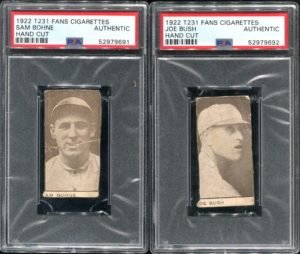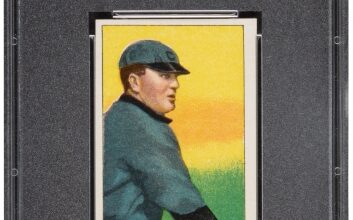Cool Find: Two New 1922 Fans Cigarette Cards Discovered

The T231 Fans Cigarettes set is an incredibly scarce type. But recently, the known checklist has nearly doubled with the find of two new cards.
Nearly doubled with the addition of two cards? No, that’s not a typo. The 1922 Fans Cigarettes cards are so rare that only three were previously known to date. The three known cards were Larry Gardner, Carson Bigbee, and Hall of Famer Home Run Baker. But even more astounding is how many are assumed to have been printed in the set based on the card numbers. Bigbee’s card is said to be No. 85 in the set while the Baker and Gardner cards are numbered 61 and 65, respectively. Assuming the card numbering in the set began with the traditional No. 1, that speaks to a whole of cards missing.
Even though much isn’t known about the set, the date of issue is assumed at 1922. That is because backs contain past years of statistics for players ending in 1921. They appear to be part of some sort of a contest as the bearers of the cards were to write their name and address on the back. The text on the back states, “I select (player name that appeared on the card)…” leading us to believe that this could have been a guessing game of sorts. That, of course, could explain why so few are in existence. It is possible, after all, that the cards were mailed in and simply not returned as companies sometimes did. The backs give us the name of the issue, confirming they were packaged with Fans Cigarettes.
Despite the rarity, we know that at least one of the cards was confirmed by Jefferson Burdick. In his American Card Catalog, Burdick listed the tough set as T231. Unfortunately, like most sets catalogued, he gave no indication of their rarity or how many he had seen. His only notes state, “Baseball Players, Fans cigts., sm. sepia, numb.” One clue that Burdick must have believed the cards were somewhat rare, though, is seen in his pricing. In the 1960 edition of the book, Burdick valued these cards at a quarter — significantly higher than many other tobacco cards, including the popular but more common ten-cent T205 and T206 cards.
The last card in the T231 Fans set was discovered practically ten years ago and since then, collectors have been searching for more, but none have surfaced.
Until now.
A One-of-a-Kind Find


Enter collector Scott Alpaugh. By his estimation, Alpaugh purchased several dozen pre-war cards approximately 35 years ago from a card show. Some were strip cards but the remainder were a mix of early candy, food, and tobacco issues.
“Most of the cards that were in the lot were hand cut and significantly trimmed,” Alpaugh recounted. “Some much more egregiously cut than others.” Still, he recalled some bigger names being a part of the lot and was hoping to turn a profit on those. But some of the cards that he had were not able to be identified, so he put them away for the time being.
Fast forward about 25 years. Alpaugh noticed one card sold by Heritage Auctions– the famous Baker example. In 2015, the Baker card, admittedly a much cleaner SGC 20, sold for nearly $11,000. Alpaugh believed he had purchased a couple of the same type of cards as part of that aforementioned card show pickup but had trouble finding them.
“I had a flashback and recalled that I may have something similar and would need to dig into my collection to see if they were still there,” Alpaugh stated.
Alpaugh would not easily find the cards. According to him, he endured “several fruitless searches, digging through boxes in storage, and wasting away several weekends” before finally locating what he’d been searching for — two badly trimmed but apparently legitimate T213 Fans Cigarettes cards of Sam Bohne and Joe Bush.
Neither is a Hall of Fame player but both were solid major leaguers. Bohne lasted seven seasons in major league infields, primarily playing with the Cincinnati Reds. Bush was more successful, winning 196 games over a 17-year career with seven different teams.
Alpaugh knew he had something but that he would need to get the cards authenticated.
Grading Confirmation Didn’t Come Easy


Alpaugh figured the cards were legitimate but finding a grading company that would agree was just as difficult as locating the cards themselves.
“PSA gave originally gave me the chicken/egg argument – they can’t be authenticated/slabbed since they’re ‘uncatalogued’, Alpaugh remembered.
That isn’t uncommon. If a card is entirely new to the hobby, graders can be reluctant to give it their stamp of approval. Alpaugh also had another issue. “The other problem was that when these were cut, the numbers were removed, so adding them to the set was a bit tricky since the numbers would be unknown,” he said.
SGC and Beckett both declined to authenticate the cards before Alpaugh, armed with more evidence and research, went back to PSA. This time they concurred with him that the cards were authentic and ultimately graded them.
Unfortunately, the missing numbers don’t give us any more insight to the checklist. If they were also ‘higher’ numbers starting in the 60s, 70s, or 80s, some might wonder if the set could have started out at a higher number as opposed to No. 1. That is unusual, of course, but not unprecedented. For example, the 1937 O-Pee-Chee baseball card set numbering starts at No. 100 instead of No. 1.
Tantalizingly, Bush’s card appears to have a No. 1 as the first digit showing. That seemingly would make it a low-number card — unless, of course, that it is 100 or higher. It’s just impossible to tell and, for now, the card numbers remain unknown.
That’s disappointing — particularly in the case of Bush’s card where we get a sliver of potential. But you sort of take what you can get when it comes to discoveries such as these. Adding such rare cards to an impossible checklist will have to be good enough in this case — even if the numbers aren’t known.





